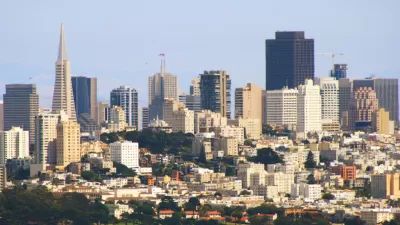When writing city plans, past planners in San Francisco got some things just right—and some very wrong.

Our readers don't need to be told that city planning is a complicated endeavor. As John King writes, the history of San Francisco's urban plans provides an illuminating example of how assumptions about urban growth can be short-sighted or naive.
King gives five examples of policies that have not panned out in the way the city expected. For example, the elevated pedestrian walkways designed in the 1960s to help pedestrians cross streets more safely have proven to deaden street life, falling out of favor with contemporary planners. Meanwhile, a law that restricted building heights near freeways in order to preserve "views" for drivers has become obsolete as planners now view high-rise towers as an appropriate way to increase density and put more housing near economic centers and transit.
As King notes, the city's 1985 Downtown Plan called for buildings that maintained the "complex architectural qualities of older San Francisco buildings," but today's planners see modern design as a potential boon to historic neighborhoods.
San Francisco plans in the 1990s also emphasized the importance of the ground floor, mandating first-floor residential units and retail. While ground-floor retail remains an important cornerstone of walkable urbanism, competition from big-box stores, high rents, and hostility from landlords mean that many of these spaces remain vacant, failing to bring the "eyes on the street" that planners desire.
Ultimately, King's observations show that urban design and planning are living, evolving fields, and planning documents should reflect a consistent reevaluation of interventions and their real-world results.
FULL STORY: You think planning a city like S.F. is easy? Here are five things that planners got wrong

Maui's Vacation Rental Debate Turns Ugly
Verbal attacks, misinformation campaigns and fistfights plague a high-stakes debate to convert thousands of vacation rentals into long-term housing.

Planetizen Federal Action Tracker
A weekly monitor of how Trump’s orders and actions are impacting planners and planning in America.

San Francisco Suspends Traffic Calming Amidst Record Deaths
Citing “a challenging fiscal landscape,” the city will cease the program on the heels of 42 traffic deaths, including 24 pedestrians.

Houston Mayor Kills Another Bike Lane
The mayor rejected a proposed bike lane in the Montrose district in keeping with his pledge to maintain car lanes.

Aging NYC Subway Cars No Match for Extreme Heat
The MTA receives thousands of complaints about broken air conditioning on subway cars each summer.

Cleveland to Boost Bike Safety With New Bike Lanes, School Programs
The program, using curriculum created by Cleveland Bikes, is part of a broader effort to improve safety along school routes.
Urban Design for Planners 1: Software Tools
This six-course series explores essential urban design concepts using open source software and equips planners with the tools they need to participate fully in the urban design process.
Planning for Universal Design
Learn the tools for implementing Universal Design in planning regulations.
Gallatin County Department of Planning & Community Development
Heyer Gruel & Associates PA
JM Goldson LLC
City of Camden Redevelopment Agency
City of Astoria
Transportation Research & Education Center (TREC) at Portland State University
Jefferson Parish Government
Camden Redevelopment Agency
City of Claremont





























